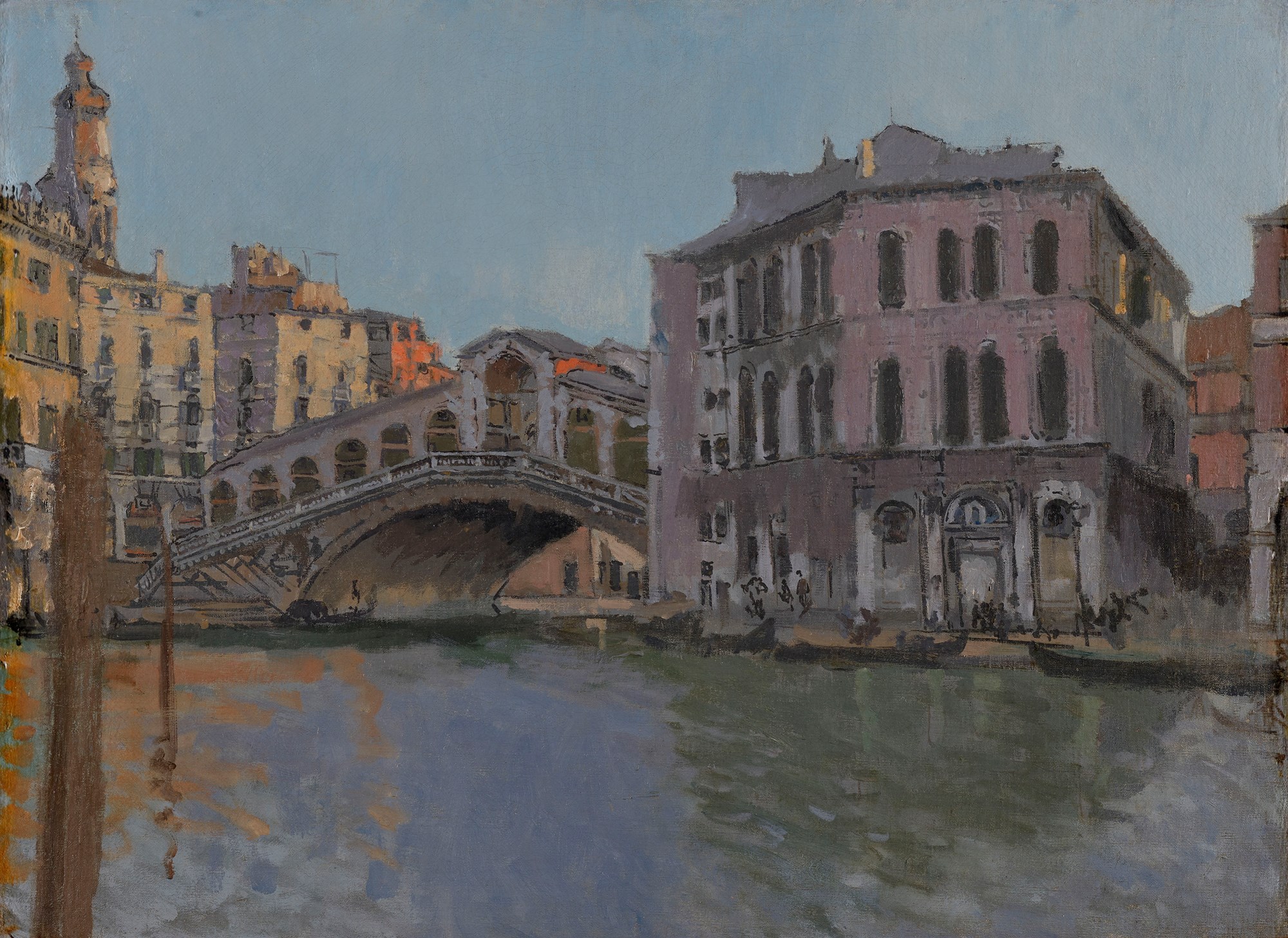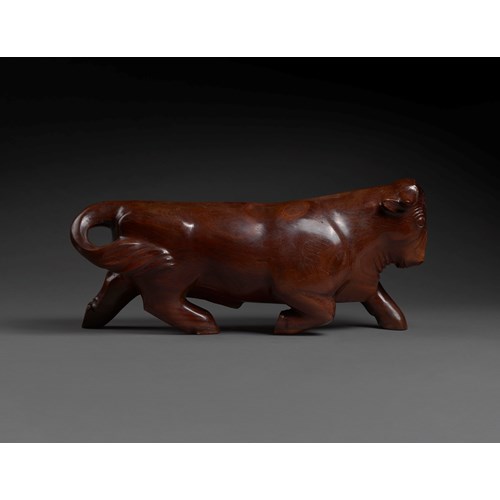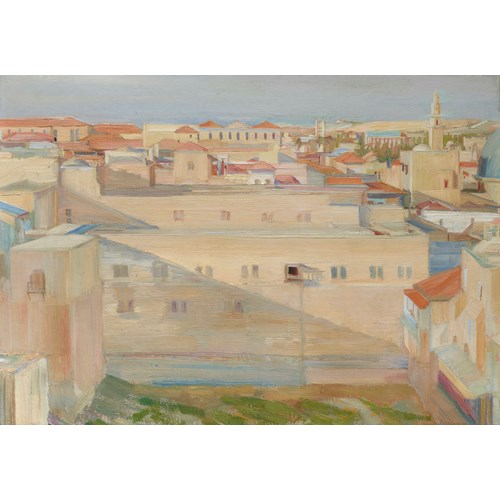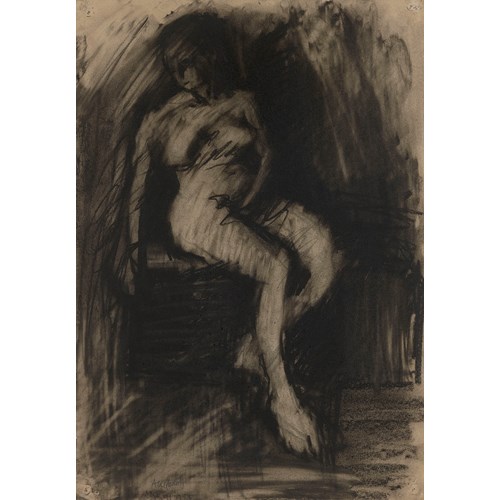Walter Sickert
The Rialto Bridge and the Palazzo dei Camerlenghi
Date c. 1901
Period Early 20th century
Medium Oil on canvas
Dimension 75 x 52 cm (29¹/₂ x 20¹/₂ inches)
Likely painted in 1901-2, The Rialto Bridge and the Palazzo dei Camerlenghi is from a formative period in Sickert’s burgeoning career - one which would go on to span six decades.
The landscape looks South-West onto the Grand Canal, Venice, where it bends around the angled faced of the Palazzo dei Camerlenghi (1523-5) toward the famous landmark of the Rialto Bridge - originally a wooden structure replaced by an impressive stone one in 1588.
Sickert has melodiously captured the late afternoon light of a summer’s day. The sun slips behind the Rialto Bridge, catching the spire of San Bartolomeo, as well as other rooftop chimneys and open windows. Simultaneously, Sickert has used purples, greens and oranges to suggest the colourful reflection on la Serenissima’s famous water, of the intense light reverberating off the city’s equally mesmerising architecture.
Sickert had first become acquainted with Venice long before actually visiting – when as James McNeill Whistler’s studio assistant, he had helped print Whistler’s series of Venetian etchings in London from around 1882 onwards (Fig.1.). Work on this project would have given Sickert good initial knowledge of The Floating City and its layout, and he undoubtedly imbibed a feel for its beauty and culture through Whistler’s images and personal reminiscences.
As testified by Whistler, Venice has long been the artists’ muse, and for Sickert this was no different - despite his subsequent association with a distinctly British art centred around everyday scenes of North London (and in particular the cheap bedsits of Camden). Sickert called Venice ‘the loveliest city in the world’ and he first visited in October 1894 making a subsequent succession of longer visits in 1895-6, 1900, 1901 and 1903-4. Venice was undoubtedly the crucible upon which his mature work was formed[1] and between 1895-1903 Sickert focused solely on painting Venice’s grand vistas and buildings. In doing so he began to form his own distinctive style of Impressionism, informed also by Degas’ practice of close cropping – as exemplified by his inclusion of Canal Poles or “Pali di Casada” in the foreground of the present painting.
Amongst British artists Sickert was a central figure to be found painting in Venice in those early years of the twentieth century. The realist plein air painter William Logsdail encountered Sickert painting in the open air when he arrived at the Ponte della Paglia to set up his own easel and watched him, recalling the intensity of his painting as, ‘like a master of fence, backing and lunging with sudden stabs at the canvas…’ and that ‘the American [painter William Gedney] Bunce…caught sight of a button on the pavement which he picked up and offered to Sickert, and looking at his trousers said, ‘Excuse me Sir, but I think this has worked loose!’.
Whilst one might imagine that Sickert’s sojourns in the ‘loveliest city’ in the world were a period of halcyon days they were in fact marred by a significant period of personal setback and suffering in his personal life. His marriage was collapsing, making Sickert somewhat despondent, and furthermore, his career was also struggling, which had left his fiscal affairs in a worrying position. It makes the striking modernity and originality of landscapes and portraits he produced during this time, including The Rialto Bridge and the Palazzo dei Camerlenghi, set against this backdrop of personal turmoil, all the more impressive.
Another version of this subject, depicting the Rialto at sunset, and dated to circa 1895-6, is illustrated in Wendy Baron’s catalogue raisonné as no. 104, p. 220. A drawing, relating to this earlier depiction is also known and was published in The Savoy, in April 1896 (Baron
104.4). Sickert painted the view again, probably as a commission, for Judge William Evans in around 1907, and there is also a print of this subject dated c.1902 (Baron 104.8, Bromberg 123). The exhibition of the present work in 1903 and Gide’s associated correspondence at
that time with Sickert himself, as well as the print of c.1902 all point to a date for the present work of around 1901.
Gide was the gifted and famous French author and winner of the Nobel Prize for Literature in 1947. His obituary in The New York Times described him as “France's greatest contemporary man of letters" and "judged the greatest French writer of this century by the literary cognoscenti." Gide wrote both fiction and autobiographical work, ranging from symbolism to anticolonialism. Overall, the main focus of his work was along the theme of investigating freedom and empowerment in the face of moralistic and puritanical constraint. In the 1920s, Gide became an inspiration for writers such as Albert Camus and Jean-Paul Sartre. In 1923, he published a book on Fyodor Dostoyevsky; however, when he defended homosexuality in the public edition of Corydon (1924) he received widespread condemnation. He later considered this his most important work.
Gide championed the arts, and had an impressive art collection informed by the artistic circles he moved in. His patronage and interest was borne out of his belief, as expressed in much of his work, for the ‘quest for an authentic life’ and that the artist was a great example of the human desire to express oneself freely, despite constraints; and thus he felt duty bound to assist their plight and offer them patronage. L’Voyage D’urien, for example, written by Gide in 1893, was an influential Symbolist text and an allegorical masterpiece, it was published in collaboration with the artist Maurice Denis who supplied the illustrations. He also knew and stayed with the influential modern British artist and critic, William Rothenstein at his home in Gloucestershire. In 1918 Gide met Dorothy Bussy (neé Strachey) wife of artist Simon Bussy – with whom he would have a long friendship and who would translate many of his works into English. In 1923, he had a daughter, Catherine, by Elisabeth van Rysselberghe, the daughter of the Belgian neo-impressionist painter Théo van Rysselberghe. It was Catharine who would subsequently inherit his art collection, including the present painting.
Gide likely first met Sickert in Dieppe, which at the turn of the 20th century was one of the most fashionable resorts in France. It was here that many artistic and literary figures including Oscar Wilde, Aubrey Beardsley, Marcel Proust, Camille Pissaro and André Gide himself stayed. Following the breakdown of his marriage, Sickert moved to Dieppe in 1898 and remained there for the next seven years. He concentrated on painting the town, capturing the spirit of the urban landscape with an informal naturalism. Gide and Sickert were both good mutual friends of the French painter Jacques Emile Blanche, who described Sickert as the 'Canaletto of Dieppe', and wrote of how, "No other artist has so perfectly felt and expressed the character of the town.”
This beautiful and particularly attractive view of Venice can be considered one of Sickert’s most enjoyable and resolved images. His pictures from this period are considered amongst his most successful and sought-after, and were particularly popular with a French audience, sold through dealers Bernheim Jeune in Paris. His impressionistic handling of the paint of the waterways, and masterful capture of the light of the city, confirm this painting as a masterpiece from his art of this period.
Date: c. 1901
Period: Early 20th century
Medium: Oil on canvas
Dimension: 75 x 52 cm (29¹/₂ x 20¹/₂ inches)
Provenance: Provenance:
André Gide (1869-1951), acquired by 1903, and by descent to;
Catherine Gide, to 2021
Literature: Literature:
Pierre Masson et Olivier Monoyez, André Gide et les peintres, Lettres inédites, Gallimard, 1919, ill. p.52
Robert Upstone, Sickert in Venice, Scala, London, 2009.
Wendy Baron, Sickert: Paintings and Drawings, 2006, Paul Mellon Centre, Yale U.P., London.
Exhibition: Exhibited:
(Probably) Paris, Durand-Ruel Gallery, Exhibition de Société Nouvelle des Peintres et Sculpteurs, 1903, ‘no. 134’ as ‘Le Pont de Rialto’, where purchased by Gide
Paris, Bernheim Jeune, Walter Sickert, 1904, as Le Rialto, lent by Gide.
Le Lavandou, Villa Théo, Collection Catharine Gide, 9-26 June 2020, no 63.
More artworks from the Gallery









